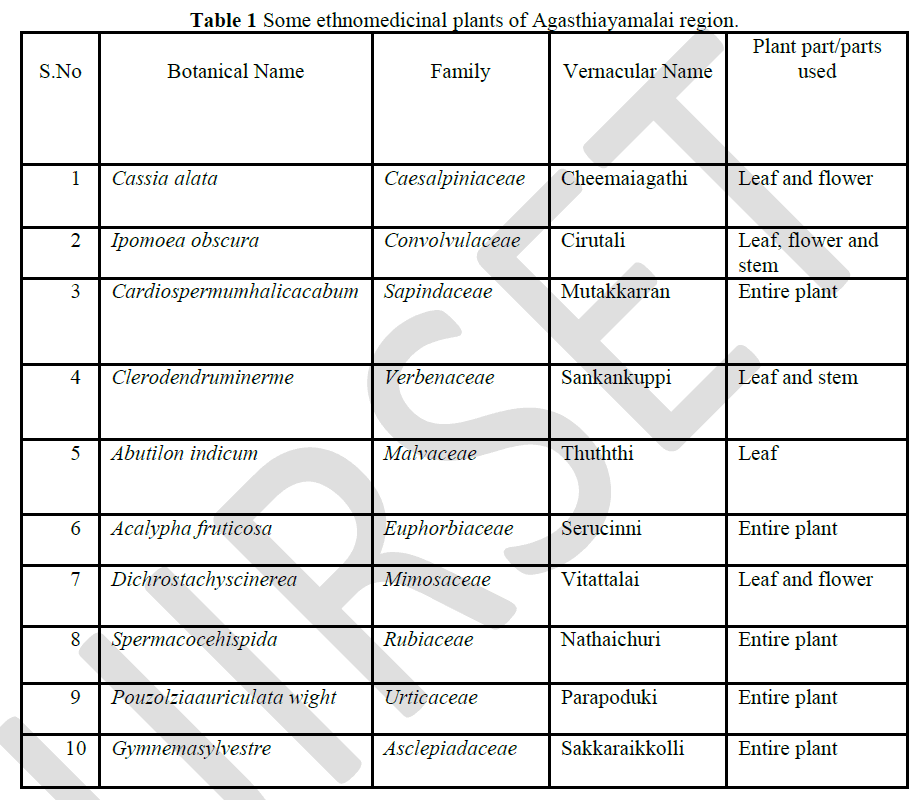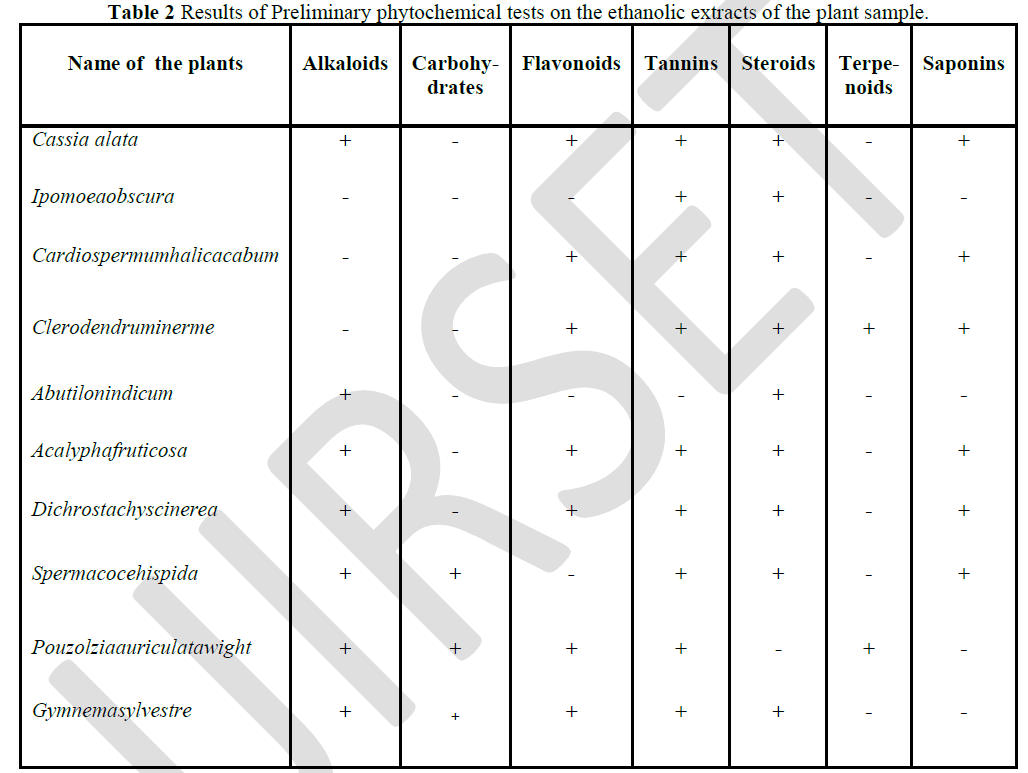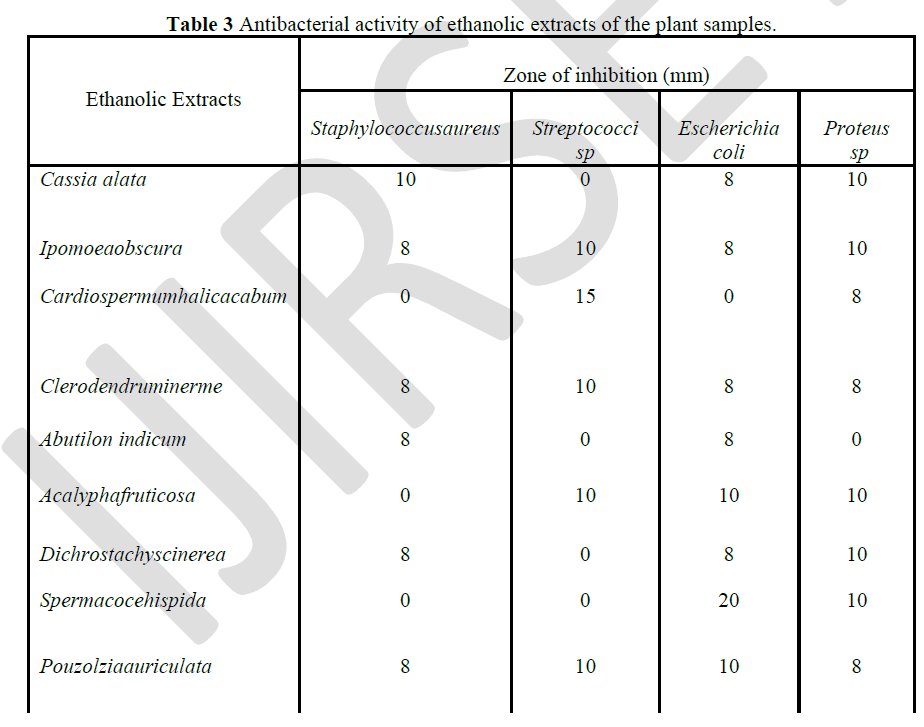ISSN ONLINE(2319-8753)PRINT(2347-6710)
ISSN ONLINE(2319-8753)PRINT(2347-6710)
N.Nirmalkumar
|
| Related article at Pubmed, Scholar Google |
Visit for more related articles at International Journal of Innovative Research in Science, Engineering and Technology
An economic botany is the study of medicinal plants in Agasthiayamalai region of Tirunelveli district was done by collecting information from the experienced medicinal practitioners of Kani tribes. Ten plants were collected, authenticated and information on their medicinal uses along with the parts used and mode of administration is enumerated. The phytochemical constituents present in their extracted materials were identified. Antibacterial activity of the extracts was analysed and zone of inhibition for different bacterial strains is reported
Keywords |
| Agasthiayamalai, ethnomedicinal uses, antibacterial activity. |
I.INTRODUCTION |
| Plants have been used in traditional medicine for several thousand years. The use of plants as medicinals by the local people have been well documented as early as 1935 by Burkill. Theophrastus (370-285 BC) began the scientific classification of plants, anddioscorides De Materia Medica (77 AD) reported the uses, medicinal and otherwise, of over 600 plants. Ibn al-Baitar (1197-1248) listed over 1400 drugs and medicinal plants in his Corpus of Simples. In India, it is reported that traditional healers use 2500 plant species and 100 species of plants serve as regular sources of medicine. Many of the methods for treating injuries and diseases have been passed down through families for generation and some of these have been adopted for use by the medicinal profession. |
| An ethnobotanical study was undertaken to collect information proposed to be useful for research on medicinal plants of theAgasthiayamalai Biosphere Reserve in Tirunelveli district of Tamil Nadu. The Agasthiayamalai Biosphere Reserve [Maridass et al., (2008)] in south Kerala is extended to parts of Kanyakumari and Tirunelveli districts lying between 77° 5' and 77° 40'E longitudes. 8°20' and 8° 50'N latitudes. Southwest monsoon from June – September, and northeast monsoon in October and November bring rain to this region, and annual rainfall varies at different places from 89 cm to 625 cm [John De Britto et al., (2007)]. The Agasthiar peak is the highest peak with an altitude of 6125 feet. Along the vast area of the Southern slopes of the Western Ghats, Tirunelveli District, theKanikkars [Ghanthi kumar et al., (2008)] live in four isolated pockets or in small hamlets. The areas of their inhabitations includeKarayar, Adukku parai, Chinnamayilar, Periya mayilar, Valuar and Inchikuzhi [V.R.Mohan et al., (2008)]. |
II.MATERIALS AND METHODS |
| The collection of plants was done on the basis of frequently used folk medicines by the Kani tribes. The plants were collected from Lowerdam, Agastiar falls and Servalar regions of Agasthiyamalai, Tirunelveli district, during February 2009. The identity of each plant was confirmed at Botanical Survey of India, and Institute of Forest Genetics and Tree Breeding Coimbatore. An exploration ofethnobotanical data of medicinal utilization of Kani tribes on Agasthiayamalai through interview of experienced practitioners revealed 10 species of plants of significant ethnomedicinal value. Table 1 gives the details of the plants revealed by the study. |
 |
| Extraction |
| The collected plant materials (Table 1) were air dried under controlled conditions to avoid too many chemical changes. The whole plant was cut into small pieces. 25g of the each dried plant material was separately extracted with ethanol for 2hrs at reflux temperature. The collected extracts were evaporated under vacuum. The residue was stored under refrigeration. |
| Preliminary colour tests |
| The qualitative identification of alkaloids was done by cream colour precipitate formation on adding small amount of Mayer’s reagent (Mercuric chloride (13.5g) and potassium iodide (50g) were dissolved in water and the solution was made upto 1000ml with distilled water). The carbohydrates in the extracts were identified by Molisch test (α- Naphthol (2.5g) was dissolved in 25ml of ethanol). The purple colour ring formation indicates the presence of carbohydrates. The extracts were tested for flavoniods by Schinoda test (few magnesium turnings and concentrated hydrochloric acid were added to solution of sample in ethanol). Pink to red in the test solution was an indication for presence of flavonoids. Tannins were identified by the green colouration formed by adding neutral ferric chloride |
 |
| solution to the alcoholic extract. Libermann-Burchard test was conducted for steroids and terpenoids (To 1ml alcoholic extract of drug 2-3ml of acetic anhydride was added, heated and cooled then 1 to 2 drops of concentrated sulphuric acid was added) A dark greencolouration of the solution indicated the presence of steroids and red colouration indicated the presence of terpenoids). Saponins were confirmed by the froth formation when 1ml of the alcoholic extract was diluted with distilled water, heated cooled and then diluted with distilled water. |
| The extracts were tested for their antibacterial activity by the disc diffusion method against two gram positive and two gram negative bacteria namely Staphylococcus aureus, Streptococci sp and Escherichia coli, Proteus sp. |
III.RESULTS AND DISCUSSION |
| The investigation revealed that a total of 10 species, distributed into different regions of Agasthiayamalai find ethnomedicinaluses for a wide range of applications in Tirunelveli district. Tribals and rural people use a variety of species from the forest as well as non-forested pockets of the study area. The information included in this study was gathered from elderly and experienced practitioners. The results of qualitative color tests of the plant extracts are given in Table 2. Among the ten plants, seven plants namely Cassia alata, Abutilon indicum, Acalypha fruticosa, Dichrostachys cinerea, Spermacoce hispida, Pouzolzia auriculata wight and Gymne masylvestre tested positive for alkaloids and Cassia alata, Cardiospermum halicacabum, Clerodendrum inerme, Acalypha fruticosa,Dichrostachys cinerea, Pouzolz ia auriculata wight, Gymnema sylvestre showed positive results for flavoniods. Except Pouzolziaauriculata wight all other plants tested positive for steroids. Clerodendrum inerme and Pouzolzia auriculata wight tested positive for terpenoids only. The antibacterial activity studies (Table 3) revealed that Cardiospermum halicacabum has highest activity against Streptococii and Spermacoce hispida has highest activity against E.coli. Most of the other extracts revealed moderate activity against the chosen bacterial strains. |
 |
 |
| Enumeration |
| Cassia alata (Tamil name: Cheemaiagathi) |
| A paste of the leaves along with turmeric is used to smoothen dry skin. |
| The leaf and flower extracts are used as a remedy for skin rashes. |
| Ipomoea obscura (L.) Ker Gaw (Tamil name:Cirutali) |
| The whole plant has medicinal value. It is used to cure cold, asthma, dry cough and chest cold |
| The fresh plant extract is mixed with gingely oil and is used to cure cold, asthma and dry cough |
| The plant extract cures pain in body by expanding the blood vessels. |
| The plant extracts is part of many siddha medicines. |
| Cardiospermum halicacabum (Tamil name: Mutakkarran) |
| The boiled juice of the plant is said to cure gastric problem. |
| The plant extract is used to cure paralysis attack and rheumatic pains. |
| Clerodendrum inerme (e) Gaertn (Tamil name: Sankankuppi) |
| The leaf extract is used to clot blood in cut wounds. |
| The leaf extract boiled with coconut oil is used to cure swellings, pains and inflammation. |
| It is used as a main ingredient in pain killer oils. |
| Abutilon Indicum (L.)Sweet subsp.indicum (Tamil name: Thuththi) |
| The yellow coloured flowers have the nature of coolness |
| The plant extract along with buttermilk is used to remove the irremovable waste from the intestine. |
| The root and stems are used in black magic. |
| It cures piles. |
| Acalypha fruticosa Forssk (Tamil name: Serucinni) |
| The plant extract is used to clean the lungs and cures the allergy in lungs |
| It cures cold. |
| It reduces breathing trouble |
| It is part of most siddha medicines. |
| Dichrostachys cinerea,(l.)Wight and Arn (Tamil name: Vitattalai) |
| Leaf and flower extracts has medicinal values. |
| Air-dried leaf and flower of the plant made as choornam mixed with honey and taken before food cures ulcer, indigestion, allergy and pains due to wounds. |
| The leaf extract along with milk is used to cure ulcer. |
| Spermacoce hispida (L.) (Tamil name: Nathaichuri) |
| It strengthens the nervous system. |
| It purifies the Red Blood Cells. |
| It has the power of mesmerizing. |
| Intake of 2 to 4 g of the seeds along with a mixture of chukku (dry ginger) and avarampoo (Cassia auriculata), coriander seed and ragi reduces the unwanted cholesterol namely LDL and HDL from the body. |
| The seeds are used to reduce body weight. |
| The intake of seeds strengthens the body. |
| Pouzolziz auriculata wight (Tamil name: Parapoduki) |
| The stem peel finds use on curing itching. |
| Gymnema sylvestre (Retz.) R.Br.ex Schult (Tamil name: Sakkaraikkolli) |
| A fine powder of dried leaves along with navalkottai and arukampul is used to cure diabetics |
| It is used to cure joint pains |
| It is used to cure breathing trouble, constipation and jaundice. |
| It cures the allergy caused due to insect bite. |
IV. CONCLUSION |
| The information obtained from this ethnobotanical study is to ensure the therapeutic efficiency of the traditional medicinal plants, which may be used as leads in developing novel therapeutic agents. Since the users are based on empirical knowledge, scientific studies of all these herbal drugs are highly desirable to establish their efficiency for safe use. A recent review of literature revealed that the above medicinal plants have been only sparingly investigated for their constituents and hence the collected information may be useful for researchers in the field of ethnobotany, taxonomy and pharmacology. |
References |
|